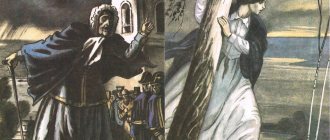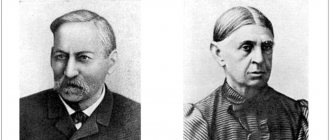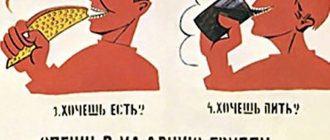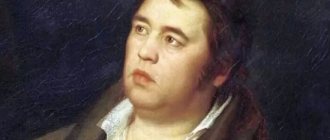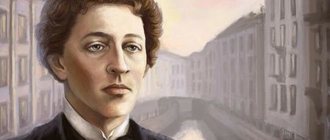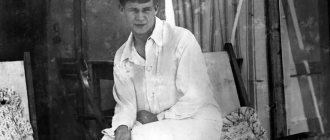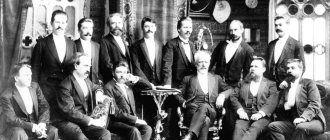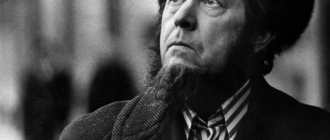Chronological table of Ostrovsky
Ostrovsky's chronological table helps to highlight the main stages of the writer's life. This article provides information about Ostrovsky’s life and work by date in a convenient form. The biography of A. N. Ostrovsky, a famous Russian playwright, will be of interest to schoolchildren and anyone interested in Russian classical literature.
Ostrovsky made a unique contribution to theatrical art. The theater business occupies a place of honor in Ostrovsky's life. The periodization of his creative path reflects the dates of development of the Russian theater associated with the founding of the Artistic Circle. The works of Alexander Nikolaevich Ostrovsky in the table are listed in chronological order. You can learn more about the playwright’s work in a special section.
1823, March 31 – A.N. was born. Ostrovsky in Moscow in the family of an official of the Moscow departments of the Senate Nikolai Fedorovich Ostrovsky and his wife Lyubov Ivanovna.
1831 – Death of mother A.N. Ostrovsky.
1835 – Admission to the third grade of the 1st Moscow gymnasium.
1840 – Admission to the Faculty of Law of Moscow University.
1843, May - A. N. Ostrovsky left the university;
assigned to serve in the Moscow Conscientious Court.
1847, February 14 – Reading of the play “The Picture of Family Happiness” by S.P. Shevyreva, first success.
1850, March - The play “Our People - Let’s Be Numbered!” was published in No. 6 of the magazine “Moskvityanin”.
1851, February - The “young editorial staff” of “Moskvityanin” was formed.
1853, January 14 – Premiere on the stage of the Maly Theater of the comedy “Don’t Get in Your Sleigh,” the first play by A. N. Ostrovsky staged in the theater.
1853, February 22 - Death of father.
1853, November - The play “Poverty is not a vice.”
1854, November - Drama “Don’t live as you want.”
1856 – Cooperation with the Sovremennik magazine.
1860, January - The play “The Thunderstorm” was first published in No. 1 of the “Library for Reading” magazine.
1865, January - The comedy “The Voevoda” was published in No. 1 of the Sovremennik magazine.
1865, March-April - The charter of the Moscow artistic circle was approved (A.N. Ostrovsky, V.F. Odoevsky, N.G. Rubinstein).
1865, October - The play “On a Lively Place” was published in No. 9 of Sovremennik;
opening of the Artistic Circle.
1865, December - A. N. Ostrovsky was elected its foreman.
1868, November - The comedy “Simplicity is enough for every wise man” was published in issue No. 11 of the journal Otechestvennye zapiski.
1869, February 12 - Marriage to Maria Vasilyevna Vasilyeva (Bakhmetyeva).
1870, November - On the initiative of A. N. Ostrovsky, the Meeting of Russian Dramatic Writers was established in Moscow, later transformed into the Society of Russian Dramatic Writers and Opera Composers.
1873, September - “The Snow Maiden” was published in No. 9 of “Bulletin of Europe”.
1874 – A. N. Ostrovsky was unanimously elected chairman of the Society of Russian Dramatic Writers and Opera Composers.
1879 – The drama “Dowry” was published in No. 5 of Otechestvennye Zapiski.
1880, January - The comedy “The Heart is Not a Stone” was published in No. 1 of “Notes of the Fatherland.”
1880, June 6-8 – Participation in Pushkin celebrations;
"Table talk about Pushkin."
1882, January - The comedy “Talents and Admirers” is published in No. 1 of “Notes of the Fatherland.”
1882, February - Honoring A. N. Ostrovsky on the occasion of the 35th anniversary of his creative activity.
1884, January - Publication in No. 1 of “Notes of the Fatherland” of the drama “Guilty Without Guilt.”
1886, June 2 – Death of A.N. Ostrovsky. He was buried in the cemetery in Nikolo-Berezhki near Shchelykovo.
September's most popular resources for your classroom:
"The Forest King" main characters
The meaning of the title of the play "The Thunderstorm"
“Journey from St. Petersburg to Moscow” main characters
Analysis of “The Old Woman Izergil” Gorky
The city of Kalinov and its inhabitants in “The Thunderstorm”
Analysis of the poem “Confession” by Derzhavin
What is the meaning of the name of the comedy “Undergrown”?
"Dubrovsky" very brief summary
The main characters of Ostrovsky's "The Thunderstorm"
“Clean Monday” very brief summary
Popular topics today
Venetsianov Alexey Gavrilovich (1780-1847) - Russian artist, founder of his own school of painting. He began his creative journey by painting portraits. The first painting created by the artist is considered to be a portrait of his mother
The work of the Strugatsky brothers tells about a distant time when humanity reached a high stage of development and got the opportunity to travel to other planets. Now people are doing something like
Petrov-Vodkin Kuzma Sergeevich is the author of many paintings, he is a strong, original, extraordinary artist with his own unique vision of colors, shapes, compositions.
Source
Interesting answers
1839 - the future composer Modest Mussorgsky was born into an intelligent noble family. He spent the first years of his life in the Pskov province, on an estate owned by his parents. In addition to Modest, the family included his older brother Filaret
1868 - Alexey Peshkov was born, who in the future would become the great writer Maxim Gorky. Having lost his parents early, Alexey spent the first years of his life in his grandfather’s family in Nizhny Novgorod. He briefly attended parochial school, where he learned to read and write.
Majestic mountains always captivate with their beauty, inaccessibility, and severity. That is why there are so many who want to conquer them. Climbers, skiers, snowboarders, snowmobile enthusiasts
Source
Development of a literature lesson for grade 10. Presentation and material for it.
Personal life
Ostrovsky's personal happiness was largely hampered by the prejudices of his contemporary society. The nobleman's chosen one (the title passed to Alexander after his father's death in 1853) was the beautiful commoner Agrafena. She never attended school and could not write. Alexander Nikolaevich himself had to teach her to read so that the girl could be the first to appreciate the works of her husband. Alas, for almost 20 years of civil marriage, all the children were stillborn or died early. Agrafena Ivanovna also did not live long - she was not even 40. From this relationship, only one eldest son, Alexei, remained, who, however, grew up as a rather sickly and frail boy. At the age of 43, the writer married another woman - one of the most beautiful artists, Maria Bakhmetyeva. In this marriage, the wife pleased Ostrovsky with the birth of six children.
Rice. 3. A. N. Ostrovsky
Brief biography – Nikolai Ostrovsky
Option 1
Writer Nikolai Alekseevich Ostrovsky was born in the village of Viliya (Ukraine) on September 16, 1904. Possessing extraordinary abilities, he was able to enter parochial school early and graduated with honors at the age of nine.
Soon the Ostrovskys moved to Shepetovka. There, since 1916, the future writer worked as a laborer, while simultaneously studying first at a two-year school and then at a higher elementary school. After graduating in 1919, the young man joined the Komsomol and went to the front as a volunteer.
In the summer of 1920, Ostrovsky was seriously wounded in combat and was demobilized. Returning home, he studied at the Electrical Technical College, while working in his specialty.
In 1922, while taking part in the construction of the railway, the young man caught a cold and fell ill with typhoid. A combat wound and illness greatly undermined Ostrovsky’s health, so after working for only five more years, he was bedridden for life from 1927.
It was this period that became the most fruitful in the writer’s work. Having settled in Sochi, in 1930 he began work on the creation of the novel “How the Steel Was Tempered.” When the work was completed, Ostrovsky sent it to the Young Guard magazine, but the manuscript was poorly rated by reviewers.
The author obtained a second review. After this, the manuscript underwent serious editing, but eventually, in 1932, the novel began to be published in the Young Guard. Afterwards, the first part of the work was published as a separate book, followed by the second. The novel immediately gained fame in the USSR.
In 1935, Ostrovsky was awarded the Order of Lenin. In addition, he was given a house in Sochi and an apartment in Moscow.
The last months of his life, Ostrovsky was surrounded by everyone's attention and honor. The writer promised to start creating a new novel, “Born of the Storm,” but managed to finish only the first part of it, since on December 22, 1936, he died in his Moscow apartment from multiple sclerosis.
Option 2
Nikolai Alekseevich Ostrovsky was born on September 29, 1904 in the village of Viliya, Ostrozh district, Volyn province of the Russian Empire (now Ostrozhsky district, Rivne region, Ukraine) in the family of a non-commissioned officer and excise official Alexei Ivanovich Ostrovsky. The future writer was admitted early to the parochial school “due to his extraordinary abilities”; He graduated from school at the age of 9, in 1913, with a certificate of merit.
Soon after this, the Ostrovsky family moved to Shepetivka, where young Nikolai worked for hire since 1916: first in the kitchen of the station restaurant, and then as a container operator, a material warehouse worker, and a fireman’s assistant at a power plant. At the same time, he studied at a two-year school (from 1915 to 1917) and then at a higher elementary school (1917-1919), where he became close to the local Bolsheviks. During the German occupation, Ostrovsky participated in underground activities, and in March 1918 - July 1919 he was even a liaison for the Shepetovsky Revolutionary Committee.
On July 20, 1919 he joined the Komsomol. In August 1920, as a volunteer, he was seriously wounded in the back by shrapnel near Lvov and demobilized. In 1921, Ostrovsky worked as an assistant electrician in the Kyiv main workshops, studied at the Electrical College, and the writer managed to hold the position of secretary of the Komsomol organization! In 1922, during the construction of the railway, he caught a bad cold and then fell ill with typhus. But Ostrovsky managed to overcome a serious illness and, after recovery, became the commissar of the Vsevobuch battalion in Berezdov (in the region bordering Poland), combined this title with the position of secretary of the Komsomol district committee in Berezdov and Izyaslav, and then worked as secretary of the Komsomol district committee in Shepetovka (1924). In the same year, he officially became a Bolshevik, joining the All-Union Communist Party (Bolsheviks).
From the end of 1930, the writer, using a stencil he invented, began to write his main literary work - the novel “How the Steel Was Tempered.” The manuscript sent to the Young Guard magazine initially received a devastating review, with the caustic wording: “the types derived are unrealistic.” However, Ostrovsky did not intend to give up and obtained a second review of the manuscript. The manuscript was edited by the deputy editor-in-chief of the Young Guard, Mark Kolosov, and the executive editor, Anna Karavaeva.
In April 1932, the Young Guard magazine began publishing Ostrovsky's novel; in November of the same year, the first part was published as a separate book, followed by the second part. The novel immediately gained great popularity in the USSR, and subsequently became a cult classic.
In 1935, Ostrovsky received the Order of Lenin, he was given a house in Sochi and an apartment in Moscow on Gorky Street (now his house-museum), and was given the rank of brigade commissar. The last few months of his life, the writer was surrounded by universal honor, receiving readers and writers at home. Moskovsky Dead Lane (now Prechistensky), where he lived in 1930–1932, was renamed in his honor. Nikolai Ostrovsky took it upon himself to write a new novel, “Born of the Storm” (under the same name as the lost early novel, but with a different plot) in three parts and even managed to write the first part, but the novel was recognized as weaker than the previous one, including and Ostrovsky himself. The novel's manuscript was typed and printed in record time, and copies of the book were given to loved ones at the writer's funeral.
Option 3
Nikolai Alekseevich Ostrovsky (September 16, 1904, Viliya village, Ostrozhsky district, Volyn province - December 22, 1936, Moscow), writer, brigade commissar (1936). Son of a worker. From 1918, after the start of the German occupation, according to his official biography, he “carried out orders for the Bolshevik underground.” In the summer of 1919, a liaison officer for the Revolutionary Committee. In July 1919 he joined the Komsomol and the Red Army. He fought in special forces units (CHON), which “specialized” in punitive operations in the rear. In 1920 he served in the brigade of G.I. Kotovsky, then in the 1st Cavalry Army. In Aug. 1920 Paul Lvov was seriously wounded in the head and in October. demobilized. From 1920 he worked at the Main Railway Workshops (Kyiv), secretary of the Komsomol cell.
Interesting Facts
- Ostrovsky knew 6 European languages perfectly and translated his dramas on his own in order to earn more money and provide for his family.
- In 1863, the playwright was awarded the Uvarov Prize for his enormous contribution to the development of Russian theater.
- The work of Alexander Nikolaevich is the forerunner of modern Russian theatrical art. K. Stanislavsky and M. Bulgakov already followed in his footsteps.
- Ostrovsky was the chairman of the Society of Russian Playwrights and Composers, and actively fought for the rights of both theater workers and ordinary actors.
The video below contains an interesting overview of the work of Alexander Ostrovsky and provides additional facts from the playwright’s biography, which we recommend that you familiarize yourself with.
Previous
BiographiesMusa Jalil biography of works, feat, interesting facts from life, childhood, best poems, personal life
Next
Biographies Pushkin family parents, pedigree diagram of Alexander Sergeevich, the fate of the children of Pushkin and Goncharova, Pushkin’s brothers and sisters, grandchildren, origin of the surname
Biography of Nikolai Ostrovsky by year
Nikolai Alekseevich Ostrovsky was born on September 16 (29), 1904 in the village of Viliya, Ostrog district, Volyn province.
Ostrovsky's father, Alexey Ivanovich, worked as a maltster at a distillery. He fought with the Turks, took part in the battle of Shipka.
Ostrovsky's mother, Olga Osipovna, was a cook.
1913 - Nikolai Ostrovsky graduates from the parochial school in his native village with a certificate of merit. He was admitted to school early, “due to his extraordinary abilities.” The family soon moved to Shepetovka, where Ostrovsky entered a 2nd-grade school. By the writer’s own admission, his education was “inferior.”
1916 - 12-year-old Ostrovsky begins to work: as a container operator, in a warehouse, then as an assistant fireman. Many years later, Nikolai Alekseevich will write to M. Sholokhov: “... I am a full-time fireman and I was a good master when it came to refueling boilers. Well, I’m the “worse” writer…”
Despite his “lower” education, Ostrovsky loved to read. He preferred romantic adventure novels by F. Cooper, Walter Scott, Jules Verne, and Dumas the Father. As an adult, the writer recalled how, while reading to his mother in the evenings, “without noticing it, he began to improvise” and came up with his own plot on the go.
Under the influence of the Shepetovka Marxists, Ostrovsky is drawn into underground work and gradually becomes an activist in the revolutionary movement in Shepetivka. Brought up on romantic and adventurous bookish ideals, he accepts the October Revolution with delight.
1919 - Nikolai Ostrovsky joins the Komsomol. In the same year, he volunteered to go to the front with units of the Red Army. The future writer first fought in the G.I. division. Kotovsky, then in the 1st Cavalry Army of S.M. Budyonny.
Autumn 1920 - Ostrovsky was seriously wounded: in the battle near Lvov he was knocked out of the saddle by a close shrapnel explosion. With a wound and concussion, he ends up in the hospital. After treatment, Ostrovsky again asks to go to the front, but he is demobilized. I have to go home.
After returning from the war, Ostrovsky serves in the Cheka and participates in the fight against local gangs. Later in his life, the “stage of shock construction” begins: first as an assistant electrician in the Kyiv workshops of the South-Western Railway, then as a worker at the construction of a narrow-gauge branch for the transport of firewood to Kyiv. Here Ostrovsky manages to accomplish a feat that later cost the writer his health: he had to save the timber rafting, and Nikolai was the first to rush into the cold water. The result of the feat was a severe cold, rheumatism and typhoid infection.
1923 - 1924 - Ostrovsky was appointed military commissar of Vseobuch. Later he was sent to Komsomol work: first as secretary of the Komsomol district committee in Berezdovo and Izyaslavl, then as secretary of the Komsomol district committee in Shepetovka.
1924 - Ostrovsky joins the CPSU(b).
In the same year, Ostrovsky suffered the first attack of petrification of the joints and spine - an incurable disease, which from that moment began to progress and gradually develop into paralysis. Ostrovsky tries not to pay attention to his illness, although he now has to spend more and more time with doctors. Around this time, Nikolai decides to write a book about his time. This idea is supported by the writer’s future wife, nineteen-year-old Raisa Porfiryevna Matsyuk, the daughter of friends of the Ostrovsky family.
1927 – illness confined Ostrovsky to bed forever. But the future writer is doing everything possible so that he is not forgotten: he leads a party-Komsomol circle at home, and in absentia completes the “first round” of a komvuz. Ostrovsky writes about himself: “Physically I lost almost everything, only the undying energy of youth and a passionate desire to be useful in some way remained…”. Feeling that his eyesight is weakening, Nikolai reads for days, preferring memoirs about the Civil War and Russian classics.
Autumn 1927 - Ostrovsky begins to engage in, in his own words, “writing.” Ostrovsky called the first work, “Born by the Storm,” “the very first version of the future book “How the Steel Was Tempered.” Having finished the manuscript, the author sends it to Odessa for “fact checking” and discussion. On the way back, the manuscript was lost. For Ostrovsky, this comes as a blow, because his “six months of work” was lost.
Beginning of 1929 - Ostrovsky completely loses his sight and, in despair, contemplates suicide.
The end of 1930 - Ostrovsky finally, for the first time since the failure of 1927, has a new literary idea. He writes at night, blindly, using a stencil he himself invented. During the day, the writer’s family and friends have to decipher what was written overnight, and often rewrite it under Ostrovsky’s dictation. The manuscript created by common effort was sent to Leningrad, but no response came. The second copy was sent to the publishing house of the Komsomol Central Committee “Young Guard”. The answer was disappointing: “the inferred types are unreal.” But Ostrovsky is seeking a second review of the manuscript in the same publishing house.
For the second time, the deputy editor of the publishing house M. Kolosov and the executive editor A. Karavaeva had to review the novel “How the Steel Was Tempered.” Before publication, editors have to (on the instructions of the party) not only edit the manuscript, but also add and even rewrite it. Ostrovsky defended his work as best he could, right down to the title (the editors suggested calling the novel “Pavel Korchagin”).
April 1932 - The Young Guard begins publishing the first part of the work. For the anniversary of the revolution, the first part is published in a separate publication (November of the same year), and soon a separate book edition of the second part appears.
The novel “How the Steel Was Tempered” is becoming incredibly popular. In libraries, huge queues line up behind it, and soon the very average, in fact, work turns into the “new gospel of Soviet youth”... Collective readings and discussions were organized; the novel was published 41 times during the author's lifetime alone. Ostrovsky became a hero of the Soviet era, standing on the same level as Chapaev, Chkalov, Mayakovsky... The image of the writer - a fighter, Komsomol member, hero of the Civil War - was constantly being added to and idealized. Ostrovsky, meanwhile, dreamed of a continuation of the novel, and even the title already existed - “Korchagin’s Happiness.” They even thought about a story for children, “Pavka’s Childhood.”
1935 - Ostrovsky, fifth among writers, becomes an order bearer. The government builds him a house on the Black Sea coast and gives him an apartment in Moscow.
In the summer of the same year, the writer publicly committed himself to writing a new book, “Born of the Storm.” The new novel is conceived as a work about the struggle of the Ukrainian proletariat against Poland and at the same time about the upcoming struggle against fascism. The manuscript was created, but the author felt its artificiality.
Nikolai Alekseevich Ostrovsky - author of the novel “How the Steel Was Tempered”
Nikolai Ostrovsky is the author of the immortal work “How the Steel Was Tempered.” The events of this book and its main character, Pavka Korchagin, have long been strongly associated with selfless heroism, courage and unbending fortitude. The book was disassembled into quotes and aphorisms, but Korchagin’s statements about life and struggle still remain relevant. However, few people know that writing the novel itself was no less a test for Ostrovsky than those that befell his characters.
Slide captions:
N. E. Makovsky. “Zamoskvorechye” (1873, Novgorod Museum-Reserve)
5 Pavel Stepanovich Mochalov (1800 – 1848) Mikhail Semenovich Shchepkin (1788 – 1863)
Collaboration with magazines
A group of employees of the Sovremennik magazine. Sitting from left to right: I.A. Goncharov, I.S. Turgenev, A.V. Druzhinin, A.N. Ostrovsky. Standing: L.N. Tolstoy, D.V. Grigorovich. Social activity
Family life Ostrovsky's children. From left to right: Alexander, Sergey, Lyubov, Maria, Mikhail
Since 1867, Alexander Nikolaevich spent every summer at the Shchelykovo estate. Here he wrote nineteen plays. The main house, built in the 18th century, has never been rebuilt. It houses a memorial museum
“We have a Russian school of painting, we have Russian music, it is permissible for us to wish for a Russian school of dramatic art... The national theater is a sign of the coming of age of the nation.”
Periodization of creativity (late 1840s - early 1850s) 2) 1852 - 1854 - “Muscovitian period”: work in the Slavophile magazine “Moskvityanin”, creation of comedies “Poverty is not a vice”, “Don’t get into your own sleigh” ", "Don't live the way you want."
Periodization of creativity (late 1840s - early 1850s) 3) 1855 - 1860 - “pre-reform period”: Ostrovsky’s worldview is finally determined, the creative principles of A.N. Ostrovsky the playwright are formed, his rapprochement with the revolutionary democratic camp occurs, the most famous plays are created: “The Thunderstorm”, “Profitable Place”;
1861 – 1886 1855 – 1860 General characteristics of creativity 1847 – 1851 1852 – 1854
18 Themes of plays by A. N. Ostrovsky Plays (47) Life of the merchants Life of officials Life of the nobility Life of the intelligentsia Historical events Philosophical and symbolic tale
The playwright remained in the history of Russian literature not just “Columbus of Zamoskvorechye,” as literary criticism called him, but the creator of the Russian democratic theater, who applied the achievements of Russian psychological prose of the 19th century to theatrical practice. Ostrovsky is a rare example of stage longevity; his plays do not leave the stage - this is the sign of a truly popular writer.
“You have donated a whole library of works of art to literature, and you have created your own special world for the stage. You alone completed the building, the foundation of which was laid by Fonvizin, Griboyedov, Gogol. But only after you, we Russians can proudly say: “We have our own Russian, national theater.” It should rightly be called: “Ostrovsky Theater”. I. A. Goncharov
The main periods in Ostrovsky’s work
IDEAL ORIGINALITY OF OSTROVSKY'S PLAY WE WILL COUNT OUR OWN PEOPLE The play “We Will Count Our Own People” (first title “Bankrupt”) became a work that determined the fate of A. N. Ostrovsky. This comedy immediately took its place among the classical peaks of Russian drama. In the play, the author, with his characteristic humor, describes the merchant environment
with your habits and aspirations.
The plot of the play is based on the widespread in the last century in
case of fraud among merchants.
Material relations underlie the conflict depicted in the play.
They also determine all the features of life, morality, and behavior of the described
Ostrovsky heroes. However, the depiction of life in this comedy is more complex,
and, as will always be the case with Ostrovsky, in the very intrigue of the play all everyday material problems are brought into the realm of moral ones.
is also expressed in the fact that if Bolshov, planning a false bankruptcy,
in everything he relies on the inviolability of his patriarchal home and the loyalty of his children
and household members, then Podkhalyuzin bribes everyone: the matchmaker, the solicitor and even the boy Tishka.
and the sins of children are a sad consequence, the result of the actions of their elders. The play shows a world of immoral people, in which everyone lives according to their own laws. And the “children”, growing up, adopt the attitude of their “fathers” to life, so they do not have the slightest
doubts about what to do in the future. The artistic originality of the play lies in the fact that
● The action and characters are imbued with comic (mostly satirical);
● Laughter is directed not only against the moral squalor of the characters, but also against the conditions that gave birth to them;
● The play depicts moral imperfection, the moral inferiority of people who think exclusively in quantitative categories, who have lost their living soul;
● The action is based on a clearly defined intrigue with plot twists and turns;
● The central characters are confident that they are superior to everyone around them, and therefore can control their destinies - they do not notice their internal inconsistency;
● Bolshov is hyperbolized, the speech characteristics of Lipochka, Agrafena Kondratievna, the matchmaker, the solicitor are caricatured, the illogicality of the characters’ speech is emphasized, the emphasis is placed on the static character, the technique of plot parallelism is used, the motif of deception is repeated three times, the leitmotif of the account is used;
● Bolshov fails, Podkhalyuzin triumphs - the playwright attracts the audience to comprehend such injustice, introducing into the play a direct appeal of the characters to the viewer;
All materials presented on the site are solely for the purpose of information for readers and do not pursue commercial purposes or copyright infringement. Studall.Org (0.006 sec.)
Source
